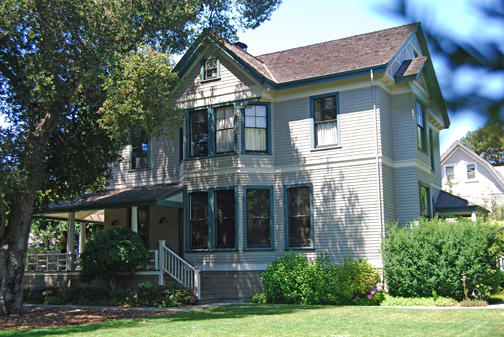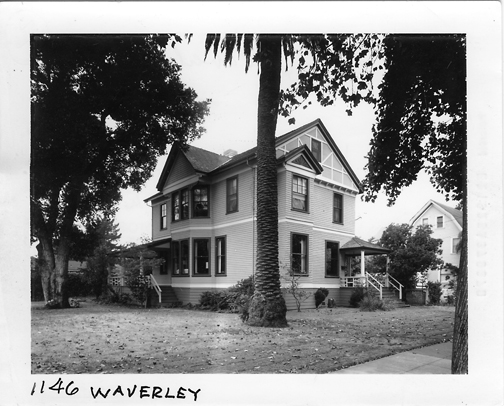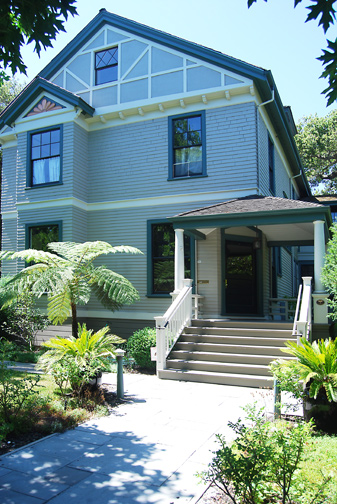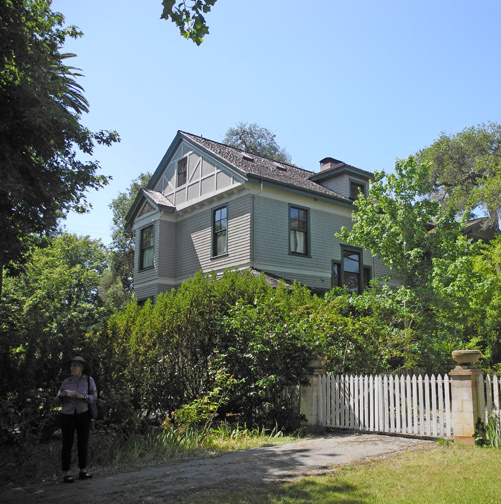 Palo Alto Stanford Heritage
Palo Alto Stanford Heritage  |
 |
| Original entry, 2010 | Robert Brandeis photo |
The marriage of Mary Elizabeth Burroughs Roberts and Albert W. Smith in 1900 united two Cornell University graduates and two well educated people intent on careers. Albert Smith (1856–1942) received his bachelor’s and master’s degrees in mechanical engineering from Sibley College, Cornell in 1879. Afterwards, he worked in industry and taught at Cornell and the University of Wisconsin. Mary Roberts (1860–1945) earned her Cornell undergraduate and master’s degrees in 1882. She spent the next eight years teaching economics and history at Wellesley College. Three years into their marriage, Leland Stanford invited Albert Smith to create a curriculum in mechanical engineering at Stanford. Mary spent her first two years at Stanford pursuing her Ph.D. and by 1894 was the first woman appointed to a full time academic position in sociology. Both remained at Stanford until 1904, when the strain of a two–career marriage took its toll in the form of a divorce and resignations from Stanford University. Albert returned to Cornell, where he became director of Sibley College until his retirement in 1921. As successful as Albert was, his career lacked the impact of Mary’s, which affected over 50% of the population. Her publications of The Almshouse Women of San Francisco followed by Why Women Are So were the first major studies of women’s lives. These works, plus numerous articles in the American Journal of Sociology and in the American Statistical Association Journal made Smith a pioneer in feminist studies by emphasizing that a woman's role in society should not be defined by her biology.
The Smiths’ move to Palo Alto meant finding housing, a difficult proposition given the meager salaries of professors at the fledgling university. What better choice to build a house then than another fledgling–architect, Charles Edward Hodges (1866–1944). Born in London, Hodges immigrated to America in 1888 at age 24. He began his architectural career working as a draftsman for the Boston firm of Shepley, Rutan and Coolidge, which had been founded by noted architect Henry Hobart Richardson. In 1893, Charles Allerton Coolidge sent Hodges west to serve as draftsman and supervising architect for the Stanford University commission which Coolidge had inherited from his mentor, Richardson. Hodges served in that capacity until 1900, when he was appointed Stanford’s Resident Architect, a post he held until his resignation in 1906. Some of the finest residences and fraternities on campus, as well as housing in Palo Alto, were designed by Hodges between 1893 and 1906. His domestic architecture allowed him free rein to demonstrate his considerable architectural skill without interference from the Stanfords. Hodges was elected an associate member of the American Institute of Architects in 1901. However, he built Albert and Mary’s house when he was a newcomer to domestic architecture.
Palo Alto’s Historic Inventory does not assign a specific architectural style to 1146 Waverley. Rather, it refers to the house as “austerely vernacular.” While this descriptor sounds pejorative, in design terms it denotes a type of residential architecture which is indigenous to a specific time or place. The designer, whether a trained professional or an apprentice, used local materials and traditional designs. Fashion is secondary to the function of the building. The two–story Smith house is a good example of the vernacular style, although it does not entirely ignore aesthetic considerations.
This well–proportioned house of 2,814 square feet is constructed of clapboard. Its front–facing gabled roof has a simplified half–timber pattern at the attic level. Exposed rafters, a frieze board under the attic overhang and string courses at the base of the first and second floors add definition to the structure.
The fenestration surrounded by wood molding, consists of large, double–hung windows with six lights in the upper panes. An attic window is differentiated in size and in its diamond patterned upper pane. Adding interest to the façade is the two story bay window with a sunburst pattern within its gabled pyramid. Another two story, three–sided bay window on the left side balances the front porch design. Wide steps lead to the hip–roofed porch, with its decorative Tuscan columns and lattice work balustrade. Sheltered by the porch is the diagonally set entry door leading to a small foyer and the public rooms. One of the latter was the music room where Mary and Albert composed the Stanford hymn, “Hail, Stanford, Hail.” You can hear a rap–remix version on YouTube. ©
 |
 |
| Waverley Street entry, 2010 | View from Waverley Street, 2015 |
PAST, October 2, 2015
E-mail us at either webmaster@pastheritage.org or president@pastheritage.org.
![]() Palo Alto Stanford Heritage—Dedicated to the preservation of Palo Alto's historic buildings.
Palo Alto Stanford Heritage—Dedicated to the preservation of Palo Alto's historic buildings.
Copyright © 2015 Palo Alto Stanford Heritage. All rights reserved.